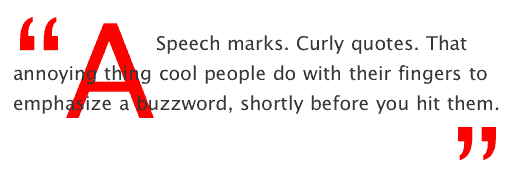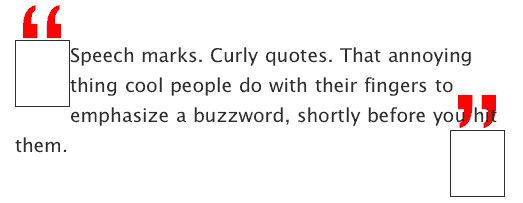Swooshy Curly Quotes Without Images

The problem
Take a quote and render it within blockquote tags, applying big, funky and stylish curly quotes both at the beginning and the end without using any images – at all.
The traditional way
Feint background images under the text, or an image in the markup housed in a little float. Often designers only use the opening curly quote as it’s just too difficult to float a closing one.
Why is the traditional way bad?
Well, for a start there are no actual curly quotes in the text (unless you’re doing some nifty image replacement). Thus with CSS disabled you’ll only have default blockquote styling to fall back on. Secondly, images don’t resize, so scaling text will have no affect on your graphic curlies.
The solution
Use really big text. Then it can be resized by the browser, resized using CSS, and even be restyled with a new font style if you fancy it. It’ll also make sense when CSS is unavailable.
The problem
Creating “Drop Caps” with CSS has been around for a while (Big Dan Cederholm discusses a neat solution in that first book of his), but drop caps are normal characters – the A to Z or 1 to 10 – and these can all be pulled into a set space and do not serve up a ton of whitespace, unlike punctuation characters.
Curly quotes aren’t like traditional characters. Like full stops, commas and hashes they float within the character space and leave lots of dead white space, making it bloody difficult to manipulate them with CSS. Styles generally fit around text, so cutting into that character is tricky indeed. Also, all that extra white space is going to push into the quote text and make it look pretty uneven. This grab highlights the actual character space:

See how this is emphasized when we add a normal alphabetical character within the span. This is what we’re dealing with here:

Then, there’s size. Call in a curly quote at less than 300% font-size and it ain’t gonna look very big. The white space it creates will be big enough, but the curlies will be way too small. We need more like 700% (as in this example) to make an impression, but that sure makes for a big character space.
Prepare the curlies
Firstly, remove the opening “ from the quote. Replace it with the opening curly quote character entity “. Then replace the closing “ with the entity reference for that, which is ”. Now at least the curlies will look nice and swooshy.
Add the hooks
Two reasons why we aren’t using :first-letter pseudo class to manipulate the curlies. Firstly, only CSS2-friendly browsers would get what we’re doing, and secondly we need to affect the last “letter” of our text also – the closing curly quote.
So, add a span around the opening curly, and a second span around the closing curly, giving complete control of the characters:
<blockquote><span class="bqstart">“</span>Speech marks. Curly quotes. That annoying thing cool people do with their fingers to emphasize a buzzword, shortly before you hit them.<span class="bqend">”</span></blockquote>So far nothing will look any different, aside form the curlies looking a bit nicer. I know we’ve just added extra markup, but the benefits as far as accessibility are concerned are good enough for me, and of course there are no images to download.
The CSS
OK, easy stuff first. Our first rule .bqstart floats the span left, changes the color, and whacks the font-size up to an exuberant 700%. Our second rule .bqend does the same tricks aside from floating the curly to the right.
.bqstart {
float: left;
font-size: 700%;
color: #FF0000;
}
.bqend {
float: right;
font-size: 700%;
color: #FF0000;
}That gives us this, which is rubbish. I’ve highlighted the actual span area with outlines:

Note that the curlies don’t even fit inside the span! At this stage on IE 6 PC you won’t even see the quotes, as it only places focus on what it thinks is in the div. Also, the quote text is getting all spangled.
Fiddle with margin and padding
Think of that span outline box as a window, and that you need to position the curlies within that window in order to see them. By adding some small adjustments to the margin and padding it’s possible to position the curlies exactly where you want them, and remove the excess white space by defining a height:
.bqstart {
float: left;
height: 45px;
margin-top: -20px;
padding-top: 45px;
margin-bottom: -50px;
font-size: 700%;
color: #FF0000;
}
.bqend {
float: right;
height: 25px;
margin-top: 0px;
padding-top: 45px;
font-size: 700%;
color: #FF0000;
}I wanted the blocks of my curlies to align with the quote text, whereas you may want them to dig in or stick out more. Be aware however that my positioning works for IE PC and Mac, Firefox and Safari. Too much tweaking seems to break the magic in various browsers at various times. Now things are fitting beautifully:
I must admit that the heights, margins and spacing don’t make a lot of sense if you analyze them. This was a real trial and error job. Get it working on Safari, and IE would fail. Sort IE, and Firefox would go weird.
Finished
The final thing looks ace, can be resized, looks cool without styles, and can be edited with CSS at any time. Here’s a real example (note that I’m specifying Lucida Grande and then Verdana for my curlies):
“Speech marks. Curly quotes. That annoying thing cool people do with their fingers to emphasize a buzzword, shortly before you hit them.”
Browsers happy
As I said, too much tweaking of margins and padding can break the effect in some browsers. Even now, Firefox insists on dropping the closing curly by approximately 6 or 7 pixels, and if I adjust the padding for that, it’ll crush it into the text on Safari or IE. Weird. Still, as I close now it seems solid through resizing tests on Safari, Firefox, Camino, Opera and IE PC and Mac. Lovely.
It’s probably not perfect, but together we can beat the evil typographic limitations of the web and walk together towards a brighter, more aligned world. Merry Christmas.
About the author
Simon Collison is a designer, author and speaker with a decade of experience at the sharp end. He co-founded Erskine Design back in 2006, but left in early 2010 to pursue new and exciting challenges, including writing an ambitious new book, and organising the New Adventures in Web Design event. Simon has lived in London and Reykjavik, but now lives back in his hometown of Nottingham, where he is owned by a cat.
Photo: Lachlan Hardy







